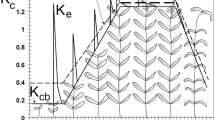Abstract
Extreme precipitation events are expected to increase in frequency and magnitude in future due to global warming, but relevant impacts on tree plantation ecosystem carbon cycle are unknown. In this study, we use an atmosphere–vegetation interaction model (AVIM2) to estimate the likely impacts of extreme precipitation events on carbon fluxes and carbon stocks of a tree plantation in south China. Our results indicate that shifting from moderate precipitation events to extreme precipitation events whilst keeping monthly precipitation unchanged could decrease the tree plantation carbon accumulation. Tree plantation net primary productivity, net ecosystem productivity, soil carbon stock and vegetation carbon stock could decrease by 4.2, 28, 4.3 and 1.4 % during the studying period of 1962–2004, respectively. Though reductions in net primary productivity and net ecosystem productivity are relatively smaller than their annual variations, our sensitivity test shows that the tree plantation carbon stock could decrease by 3.3 % if the assumed extreme precipitation regime lasts for 500 years. Observed and simulated gross primary productivity, ecosystem respiration and net ecosystem productivity have significant positive correlation with soil water content (SWC), especially the deep SWC. The mechanism for the extreme precipitation effect is that the increase in extreme precipitation events will cause SWC to decrease, consequently, reducing carbon fluxes and stocks.












Similar content being viewed by others
References
Allan RP, Soden BJ (2008) Atmospheric warming and the amplification of precipitation extremes. Science 321:1481
Bonan GB, Shugart HH, Urban DL (1990) The sensitivity of some high-latitude boreal forests to climatic parameters. Clim Chang 16:9–29
Botkin DB, Nisbet RA (1992) Forest response to climatic change: effects of parameter estimation and choice of weather patterns on the reliability of projections. Clim Chang 20:87–111
Cao M, Woodward FI (1998) Net primary and ecosystem production and carbon stocks of terrestrial ecosystems and their responses to climate change. Global Change Biol 4:185–198
Ciais P, Viovy N, Reichstein, Granier A et al (2005) Europe-wide reduction in primary productivity caused by the heat and drought in 2003. Nature 437(22):529–533
Collatz GJ, Ribas-Carbo M, Berry JA (1992) Coupled photosynthesis–stomatal conductance model for leaves of C4 plants. Aust J Plant Physiol 19:519–538
Coops NC, Waring RH (2001) Assessing forest growth across southwestern Oregon under a range of current and future global change scenarios using a process model, 3-PG. Global Change Biol 7:15–29
Dan L, Ji J (2007) The surface energy, water, carbon flux and their intercorrelated seasonality in a global climate–vegetation coupled model. Tellus B 59:425–438
Davi H, Dufrêne E, Francois C et al (2006) Sensitivity of water and carbon fluxes to climate changes from 1960 to 2100 in European forest ecosystems. Agric For Meteorol 141:35–56
Easterling DR, Meehl GA, Parmesan C, Changnon SA, Karl TR, Mearns LO (2000) Climate extremes: observations, modeling, and impacts. Science 289(22):2068–2074
Farquhar GD, Caemmerer S, Berry JA (1980) A biochemical model of photosynthetic CO2 assimilation in leaves of C3 plants. Planta 149:78–90
Fay AP, Carlisle DJ, Knapp KA, Blair MJ, Collins LS (2000) Altering rainfall timing and quantity in a mesic grassland ecosystem: design and performance of rainfall manipulation shelters. Ecosystems 3:308–319
Fay AP, Carlisle DJ, Knapp KA, Blair MJ, Collins LS (2003) Productivity responses to altered rainfall patterns in a C4-dominated grassland. Oecologia 137:245–251
Fay AP, Kaufman Md, Nippert BJ, Carlisle DJ, Harper WC (2008) Changes in grassland ecosystem function due to extreme rainfall events: implications for responses to climate change. Glob Chang Biol 14:1600–1608
Goswami BN, Venugopal V, Sengupta D, Madhusoodanan MS, Xavier PK (2006) Increasing trend of extreme rain events over India in a warming environment. Science 314:1442
Granier A, Bréda N, Biron P, Villette S (1999) A lumped water balance model to evaluate duration and intensity of drought constraints in forest stands. Ecol Model 116:269–283
Huang M, Ji J, Li K, Liu Y, Yang F, Tao B (2007) The ecosystem carbon accumulation after conversion of grasslands to pine plantations in subtropical red soil of South China. Tellus 59B:439–448
Ji JJ (1995) A climate–vegetation interaction model: simulating physical and biological processes at the surface. J Biogeogr 22:2063–2069
Ji JJ, Huang M, Li KR (2008) Prediction of carbon exchanges between China terrestrial ecosystem and atmosphere in 21st century. Sci China Ser D: Earth Sci 51:885–898
Knapp KA, Fay AP, Blair MJ, Collins LS et al (2002) Rainfall variability, carbon cycling, and plant species diversity in a mesic grassland. Science 298:2202–2205
Li ZP, Wang XJ (2000) Analysis and devaluation of soil organic matter dynamics at a little region scale (In Chinese). Sci Geograph Sin 20(2):45–50
Liu YF, Yu GR, Wen XF, co-authors (2006) Seasonal dynamics of CO2 fluxes from sub-tropical plantation coniferous ecosystem. Sci China Ser D 49(II):99–109
Lu J, Ji J (2006) A simulation and mechanism analysis of long-term variations at land surface over arid/semi-arid area in north China. J Geophys Res 111(D09306):1–19
McGuire AD, Joyce LA, Kicklighter DW, Melillo JM et al (1993) Productivity response of climax temperate forests to elevated temperature and carbon dioxide: a north American comparison between two global models. Clim Chang 24:287–310
Parton WJ, Schimel DS, Cole CV, Ojima DS (1987) Division S-3-soil microbiology and biochemistry. Analysis of factors controlling soil organic matter levels in great plains grasslands. Soil Sci Soc Am J 51:1173–1179
Reichstein M, Tenhunen J, Roupsard O et al (2003) Inverse modeling of seasonal drought effects on canopy CO2/H2O exchange in three Mediterranean ecosystems. J Geophys Res 108(D23):4726
Solomon AM, Bartlein PJ (1992) Past and future climate change: response by mixed deciduous–coniferous forest ecosystems in northern Michigan. Can J For Res 22:1727–1738
Acknowledgments
This research was supported by the State Key Basic Research Development and Planning Project (2010CB833503 and 2010CB950603) and the National Nature Science Fund (41271118 and 40975045).
Author information
Authors and Affiliations
Corresponding author
Rights and permissions
About this article
Cite this article
Huang, M., Ji, J., Deng, F. et al. Impacts of extreme precipitation on tree plantation carbon cycle. Theor Appl Climatol 115, 655–665 (2014). https://doi.org/10.1007/s00704-013-0927-8
Received:
Accepted:
Published:
Issue Date:
DOI: https://doi.org/10.1007/s00704-013-0927-8




